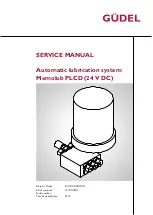
Site reparation
Installing dealers may want to speak with customers in advance and ask them to clean under the sink to save time. If a
basement installation is advisable, check area to determine if extra fittings or hosing are required. Upon arrival, it is a
good idea to check the condition of all plumbing for potential leaks and advice customer so there will be no
misunderstandings in the event leaks occur.
Unit preparation
Open shipping carton, remove components and check that all parts are present. Check empty storage tank to be sure air
pressure is approximately 7 psi. Adjust if necessary
Note: Hand tighten all fitting connections to be sure they are tight.
Installation steps
All plumbing must be completed in accordance with state and local plumbing codes. Some municipalities may require
installation by a licensed plumber. Check local authority prior to installation.
1. Faucet installation
If the sink has a sprayer it may be disconnected for faucet installation. (Installing dealers should discuss this with
customers.) A pipe cap or plug will be necessary to seal the sprayer connection. To make the faucet mounting hole (if
sprayer or second hole is not used), check below to make sure the drill does not interfere with anything below. Center
punch a small indent at the desired faucet location. (2” flat surface is required, not exceeding 1-1/4” in thickness.) Drill the
required pilot hole for the chassis punch and tighten nut to cut the desired hole size. Clean up sharp edges. The faucet
should be positioned so it empties into the sink and the spout swivels freely for convenience. If sink has a hole that can
accommodate the RO faucet, no drilling is required. Proceed with mounting the faucet.
Porcelain, Enamel, Ceramic on Metal or Cast Iron:
Precautions must be taken to penetrate the porcelain through to the metal base and prevent it from chipping or scratching.
Tools required:
Variable speed drill
Porcelain cutter tool set
(7/8" or alternative size, 9/16")
Plumber's putty
Procedures:
1. Mark the center for the 7/8” hole.
2. Form shallow putty around hole area and fill with enough water to lubricate carbide drill bit.
3. Carefully drill pilot hole through all layers. (Use light pressure and slow speed.)
4. Insert pilot tip of spring-loaded porcelain cutter into pilot hole.
5. Drill porcelain / enamel using spring loaded porcelain cutter, making certain a complete ring
has been cut through the porcelain / enamel to the metal base.
6. Cut away the inner porcelain / enamel disc down to the base metal. Make certain the cutter does not
touch the outer rim of the cut porcelain / enamel. Continue with this bit to cut through metal
until sink has been completely penetrated.
Note: Always use sharpened porcelain cutter to
eliminate chips and cracks.
Faucet installation without air gap
Installation procedures for stainless steel sinks
































